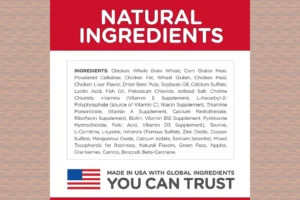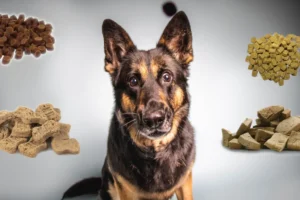Note: We may earn a commission from helpful, relevant links in our content. No cost to you. See our privacy policy.

Cats with sensitive stomachs are like furry, adorable puzzle boxes – figuring out the right combination of diet and care can be a head-scratching affair. But when your feline friend reacts badly to their current dinner menu, you know it’s time for a change.
In this post, we’ll walk through selecting the best dry cat food to soothe your kitty’s sensitive tummy, offering them relief and you, peace of mind.
Quick Takeaways:
- Choose cat food with limited ingredients, focusing on easily digestible proteins like chicken or turkey, and ensure it’s free from artificial additives.
- Transition your cat to a new food gradually over a week or two, starting with a mix of 25% new to 75% current food, to avoid digestive upset.
- Opt for brands like Blue Buffalo, Hill’s Science Diet, Purina ONE, Royal Canin, and Iams as top picks for cats with sensitive stomachs, due to their high-quality ingredients and gut health support.
What Makes a Cat Food ‘Sensitive Stomach-Friendly’?
When it comes to our feline pals with sensitive stomachs, not all cat food is created equal. For your whiskered friend, you want to ensure their food is as comforting to their tummy as it is delightful to their taste buds. Sensitive stomach-friendly cat food typically has a few standout traits that differentiate it from your run-of-the-mill kibble.
First off, limited ingredients play a big part. Foods that stick to a simpler recipe make it easier to pinpoint what works (or doesn’t) for your cat’s digestive system. Then there’s the protein source – high-quality, easily digestible proteins like chicken, turkey, or fish are top picks. These provide the essential nutrients without the upset. Also, let’s not forget, artificial additives are a big no-no. Artificial colors, flavors, or preservatives could be troublemakers for sensitive tummies.
Remember, the proof is in the pudding, or in this case, the kibble. High-quality, simple ingredients make a world of difference.
How Can You Tell If Your Cat Has a Sensitive Stomach?
Spotting a sensitive stomach in your feline friend can be trickier than finding a needle in a haystack. But there are tell-tale signs that shout “sensitive stomach” louder than a cat meowing for breakfast.
Keep an eye out for frequent vomiting, which can be more than just hairballs. Diarrhea or loose stools are also red flags, not to mention a lack of appetite or lethargy which could indicate their food isn’t sitting well. And if you notice these symptoms aren’t just a one-off but a regular occurrence, it’s time to have a chat with your vet. They can help rule out other health issues and guide you towards a diet that sits well with your furball.
Observation is key here. Keeping track of what and when your cat eats, along with their reactions, can provide valuable insights into what’s causing their distress.
What Ingredients Should You Look for in Cat Food for Sensitive Stomachs?
Diving into the world of cat food can feel like a wild goose chase, but knowing what ingredients to look out for can steer you in the right direction. For our sensitive-stomached friends, certain ingredients can make all the difference.
-
Easily Digestible Proteins : Look for lean meats like chicken, turkey, or rabbit. Fish is another good option, but opt for those higher in omega-3 fatty acids, which can help with inflammation.
-
Digestible Fibers : Not all fibers are created equal. Ingredients like pumpkin, sweet potato, or beet pulp can support digestive health without causing upset.
-
Probiotics : These beneficial bacteria aid in maintaining a healthy gut flora, essential for a well-functioning digestive system.
-
Healthy Fats : Omega-3 fatty acids, found in fish oil or flaxseed, are not just good for the coat but can also reduce intestinal inflammation.
Here’s a unique tip that often slips through the cracks: Hydrolyzed Proteins. For cats with real sensitivities, hydrolyzed proteins have been broken down into smaller components, making them incredibly easy to digest and less likely to trigger an immune response. Though not as commonly found, foods that feature hydrolyzed proteins can be a game-changer for troubled tummies.
When in doubt, always double-check the ingredient list and consult with your vet. They can offer advice tailored to your cat’s specific needs, ensuring their bowl is filled with nothing but goodness.
What Are the Top Picks for Dry Cat Food for Sensitive Stomachs?
Finding the right dry cat food for a kitty with a sensitive stomach can be a bit like solving a puzzle with fluffy, moving pieces. But, worry not! We’ve pawed through the options, ingredients, and feline feedback to bring you a list of top picks that should suit even the most delicate of tummies.
-
Blue Buffalo Sensitive Stomach Adult Dry Cat Food : Known for its wholesome ingredients, Blue Buffalo offers a sensitive stomach formula that includes real chicken as its first ingredient, along with prebiotic fibers for easier digestion. It’s fortified with vitamins, minerals, and a precise blend of antioxidants crafted by veterinarians and animal nutritionists to support immune system health.
-
Hill’s Science Diet Adult Sensitive Stomach & Skin Cat Food : This one is crafted with skin and stomach sensitivities in mind. It contains prebiotic fiber for gut health and omega-6 fatty acids and vitamin E for a shiny coat. Hill’s Science puts science first, meaning this formula is backed by extensive research.
-
Purina ONE Sensitive Systems Adult Dry Cat Food : A budget-friendly option that doesn’t skimp on quality. This food includes easily digestible rice and oat meal, plus real turkey as the first ingredient. It’s also enriched with antioxidants to support a robust immune system.
-
Royal Canin Digestive Care Dry Cat Food : Specifically designed for cats with sensitive stomachs, this formula boasts highly digestible proteins and a blend of prebiotics and dietary fibers to promote a balanced gut flora and improve stool quality.
-
Iams Proactive Health Sensitive Stomach Adult Cat Food : With real turkey as the first ingredient, this Iams formula not only appeals to a cat’s palate but also supports her digestion with a tailored fiber blend including prebiotics and beet pulp.
Why They Stand Out : Each of these foods addresses sensitive stomach issues from multiple angles: high-quality, easily digestible proteins; the inclusion of prebiotics and fibers for gut health; and additional support for skin, coat, and overall immune system health. When it comes to pampering a sensitive tummy, the details matter—like avoiding artificial colors, flavors, or preservatives, common irritants for many cats.
How Can You Transition Your Cat to a New Food Without Upsetting Their Stomach?
Transitioning your cat to a new food requires patience, observation, and a bit of finesse. Here’s how to do it seamlessly:
-
Start Small : Begin by mixing a small amount of the new food with their current food. A good ratio to start might be 25% new food to 75% current food. This gradual introduction helps their digestive system adjust without causing shock.
-
Slowly Increase the New Food Percentage : Over the course of a week or two, gradually increase the new food while decreasing the old, moving to a 50/50 blend, then to a 75/25 blend in favor of the new food until you’re finally able to serve only the new food without any digestive upset.
-
Monitor Your Cat Closely : Pay attention to how your cat reacts during the transition. Look for signs of discomfort, including changes in stool consistency, vomiting, or lack of appetite. If you notice any of these, slow down the transition process.
-
Keep Hydration in Mind : Ensure your cat has access to plenty of fresh water, especially important when changing diets. Good hydration can help ease the digestive process.
-
Stick to a Schedule : Consistency is key. Try to feed your cat at the same times every day to help stabilize their digestive system.
One Unique Tip : Amid this transition, consider adding a small amount of plain, canned pumpkin to your cat’s food. Not only is it rich in fiber, which can help with digestion, but many cats also find pumpkin appealing. This little hack isn’t widely known but can be a game-changer for sensitive stomachs.
Switching foods doesn’t have to be a tumultuous time. With a gentle approach and keen observation, you can ensure your cat’s diet change is as smooth as their coat. Remember, when in doubt, consult your vet, especially if your kitty shows signs of distress or allergies. They’re your best ally in keeping your feline friend happy and healthy.
Alex, a passionate animal lover, has experience in training and understanding animal behavior. As a proud pet parent to two dogs and three cats, he founded AnimalReport.net to share insights from animal experts and expand his knowledge of the animal kingdom.









